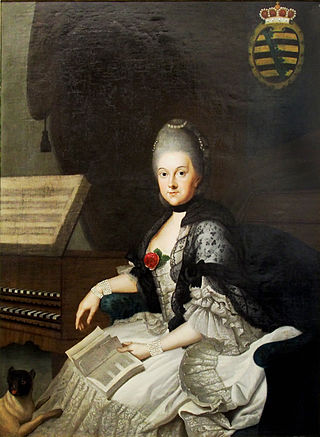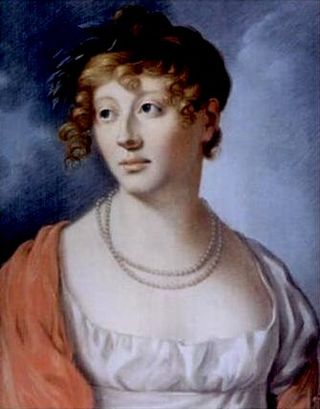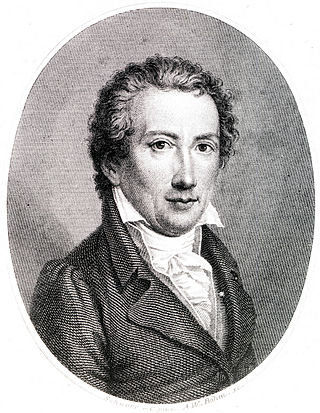
Johann Gottfried von Herder was a German philosopher, theologian, poet, and literary critic. He is associated with the Enlightenment, Sturm und Drang, and Weimar Classicism. He was a Romantic philosopher and poet who argued that true German culture was to be discovered among the common people. He also stated that it was through folk songs, folk poetry, and folk dances that the true spirit of the nation was popularized. He is credited with establishing or advancing a number of important disciplines: hermeneutics, linguistics, anthropology, and "a secular philosophy of history."

Bettina von Arnim, born Elisabeth Catharina Ludovica Magdalena Brentano, was a German writer and novelist.

Anna Amalia of Brunswick-Wolfenbüttel, was a German princess and composer. She became the duchess of Saxe-Weimar-Eisenach by marriage, and was also regent of the states of Saxe-Weimar and Saxe-Eisenach from 1758 to 1775. She transformed her court and its surrounding into the most influential cultural center of Germany.

Johann Heinrich Merck, German author and critic, was born at Darmstadt, a few days after the death of his father, a chemist.

Caroline of the Palatinate-Zweibrücken was Landgravine of Hesse-Darmstadt by marriage to Louis IX, Landgrave of Hesse-Darmstadt. She was famed as one of the most learned women of her time and known as The Great Landgräfin.

Baroness Karoline Jagemann von Heygendorff was a major German tragedienne and singer. Her great roles included Elizabeth in Mary Stuart (1800) and Beatrice in The Bride of Messina (1803). She is also notable as a mistress of Karl August, Grand Duke of Saxe-Weimar-Eisenach, the father of her three children. Both she and Karl August had their portraits painted by Heinrich Christoph Kolbe.

Johann Martin Miller was a German theologian and writer. He is best known for his novel Siegwart, which became one of the most successful books at the time.

Charlotte Luise Antoinette von Schiller was the wife of German poet Friedrich Schiller.
Heinrich Doring, born Michael Johann Heinrich Döring was a German writer, theologian and mineralogist.

Johann Friedrich Rochlitz was a German playwright, musicologist and art and music critic. His most notable work is his autobiographical account Tage der Gefahr about the Battle of Leipzig in 1813 — in Kunst und Altertum, Goethe called it "one of the most wondrous productions ever to have been written". A Friedrich-Rochlitz-Preis for art criticism is named after him — it is awarded by the Leipzig Gesellschaft für Kunst und Kritik and was presented for the fourth time in 2009.

Otto Roquette was a German author.

Prince August of Saxe-Gotha-Altenburg was a German prince of the Saxe-Gotha-Altenburg line of the Ernestine Wettins and a patron of the arts during the Age of Enlightenment.
Franz Michael Leuchsenring was a German writer of the German Enlightenment.
Sophie von Schardt was a well connected member of the Weimar court circle during the "classic" period. Mme de Staël thought her among the most sympathetic women in Weimar while Goethe himself, who enjoyed her company, referred to her as the "little Schardt". She also wrote poems herself, which were mostly short lyric pieces, and produced translations from English and Italian.

Carl Ernst Christoph Hess, or Carl Ernst Heß was a German copper engraver and painter.
Ernst Heinrich Anton Pasqué was a German operatic baritone, opera director, theatre director, writer and librettist.

August von Herder was a German geologist and mineralogist. From 1813 he served in a succession of increasingly senior posts in the Saxon government mines service, ending up in 1826 as government mining director ("Berghauptmann"). He was an energetic and highly effective moderniser of the Saxon mining industry.
Christian Johann Christoph Schreiber was a German theologian, philologist, philosopher, and poet. He was also the Superintendent of the dioceses of Lengsfeld and Dermbach. He was connected in friendship or correspondence to writers and philosophers of his time, and published poetry, sermons, historical and philosophical works.

Martin Gottlieb Klauer was a German sculptor, and one of the first teachers at the Weimar Princely Free Drawing School.

Traugott Maximilian Eberwein, was a German composer and conductor, who is attributed with the start of early musical history in Rudolstadt.
















